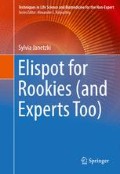Abstract
Elispot is the abbreviation for Enzyme-Linked ImmunoSpot. The name was deduced from the name for another immunological test, ELISA, a technique that is in parts similar to Elispot, and from the fact that spots are the actual readout of the assay. Elispot has been around for many years. It was first described in 1983 for the detection of heat-labile enterotoxin production of bacteria [1], followed by its use for the enumeration of specific antibody-secreting B cells [2]. The assay format was further adapted for the detection of cytokine-secreting cells, and remained generally almost unchanged until today [3]. The assay has gained popularity over the years with a renaissance in the mid-late 1990s, driven by the cancer and HIV research fields [4], which in turn encouraged manufacturers to improve on basic materials and reagents used for the assay to increase its reliability. Their introduction to the field, the availability of newly developed automated Elispot plate readers for the assay analysis [5], and the start of activities focused on assay standardization, harmonization, and validation further boosted Elispot to its current state as one of the most commonly used immunological assays in a wide range of fields and applications, including the research and translational fields of cancer, infectious and autoimmunity-related diseases, transplantation, basic immunology, as well as genetic diseases and AAV-based therapies, and even epidemiology and research on trauma-related injuries of various organs. Over the past decade, an average of 300–400 scientific papers were published each year referring to Elispot. With that, the question arises why Elispot has remained in its popularity and does not seem to fade away into the dungeon of outdated techniques despite the fact that new immunological as well as molecular-biological methods are constantly being introduced that allow scientists to examine the state and/or functions of the immune system and other cells, e.g., polychromatic flow cytometry, HLA multimer-peptide staining, mass cytometry (CyTOF), or T-cell receptor (TCR) sequencing, just to name a few. To answer the question, we need to look at Elispot a little closer.
Access this chapter
Tax calculation will be finalised at checkout
Purchases are for personal use only
References
Czerkinsky CC, Svennerholm AM. Ganglioside GM1 enzyme-linked immunospot assay for simple identification of heat-labile enterotoxin-producing Escherichia coli. J Clin Microbiol. 1983;17(6):965–9.
Czerkinsky CC, Nilsson LA, Nygren H, Ouchterlony O, Tarkowski A. A solid-phase enzyme-linked immunospot (ELISPOT) assay for enumeration of specific antibody-secreting cells. J Immunol Methods. 1983;65(1-2):109–21.
Czerkinsky C, Andersson G, Ekre HP, Nilsson LA, Klareskog L, Ouchterlony O. Reverse ELISPOT assay for clonal analysis of cytokine production. I. Enumeration of gamma-interferon-secreting cells. J Immunol Methods. 1988;110(1):29–36.
Cox JH, Ferrari G, Janetzki S. Measurement of cytokine release at the single cell level using the ELISPOT assay. Methods. 2006;38(4):274–82.
Herr W, Linn B, Leister N, Wandel E, Meyer zum Büschenfelde KH, WolfeI T. The use of computer-assisted video image analysis for the quantification of CD8+ T lymphocytes producing tumor necrosis factor alpha spots in response to peptide antigens. J Immunol Methods. 1997;203(2):141–52.
Jahnmatz M, Kesa G, Netterlid E, Buisman AM, Thorstensson R, Ahlborg N. Optimization of a human IgG B-cell ELISpot assay for the analysis of vaccine-induced B-cell responses. J Immunol Methods. 2013;391(1-2):50–9.
Boulet S, Ndongala ML, Peretz Y, Boisvert MP, Boulassel MR, Tremblay C, et al. A dual color ELISPOT method for the simultaneous detection of IL-2 and IFN-gamma HIV-specific immune responses. J Immunol Methods. 2007;320(1-2):18–29.
Janetzki S, Rueger M, Dillenbeck T. Stepping up ELISpot: multi-level analysis in FluoroSpot assays. Cells. 2014;3(4):1102–15.
Gazagne A, Claret E, Wijdenes J, Yssel H, Bousquet F, Levy E, et al. A Fluorospot assay to detect single T lymphocytes simultaneously producing multiple cytokines. J Immunol Methods. 2003;283(1-2):91–8.
Ahlborg N, Axelsson B. Dual- and triple-color fluorospot. Methods Mol Biol. 2012;792:77–85.
Dillenbeck T, Gelius E, Fohlstedt J, Ahlborg N. Triple cytokine FluoroSpot analysis of human antigen-specific IFN-gamma, IL-17A and IL-22 responses. Cells. 2014;3(4):1116–30.
Körber N, Behrends U, Hapfelmeier A, Protzer U, Bauer T. Validation of an IFNgamma/IL2 FluoroSpot assay for clinical trial monitoring. J Transl Med. 2016;14(1):175.
Kesa G, Larsson PH, Ahlborg N, Axelsson B. Comparison of ELISpot and FluoroSpot in the analysis of swine flu-specific IgG and IgA secretion by in vivo activated human B cells. Cells. 2012;1(2):27–34.
Jahnmatz P, Bengtsson T, Zuber B, Farnert A, Ahlborg N. An antigen-specific, four-color, B-cell FluoroSpot assay utilizing tagged antigens for detection. J Immunol Methods. 2016. doi:10.1016/j.jim.2016.02.020.
Hadjilaou A, Green AM, Coloma J, Harris E. Single-cell analysis of B cell/antibody cross-reactivity using a novel multicolor fluorospot assay. J Immunol. 2015;195(7):3490–6.
Smedman C, Ernemar T, Gudmundsdotter L, Gille-Johnson P, Somell A, Nihlmark K, et al. FluoroSpot analysis of TLR-activated monocytes reveals several distinct cytokine secreting subpopulations. Scand J Immunol. 2011. doi:10.1111/j.1365-3083.2011.02641.x.
Author information
Authors and Affiliations
Rights and permissions
Copyright information
© 2016 Springer International Publishing Switzerland
About this chapter
Cite this chapter
Janetzki, S. (2016). Overview. In: Elispot for Rookies (and Experts Too). Techniques in Life Science and Biomedicine for the Non-Expert. Springer, Cham. https://doi.org/10.1007/978-3-319-45295-1_1
Download citation
DOI: https://doi.org/10.1007/978-3-319-45295-1_1
Published:
Publisher Name: Springer, Cham
Print ISBN: 978-3-319-45293-7
Online ISBN: 978-3-319-45295-1
eBook Packages: Biomedical and Life SciencesBiomedical and Life Sciences (R0)

